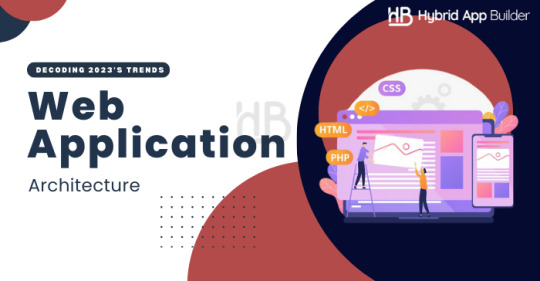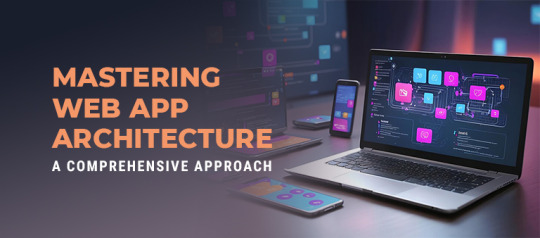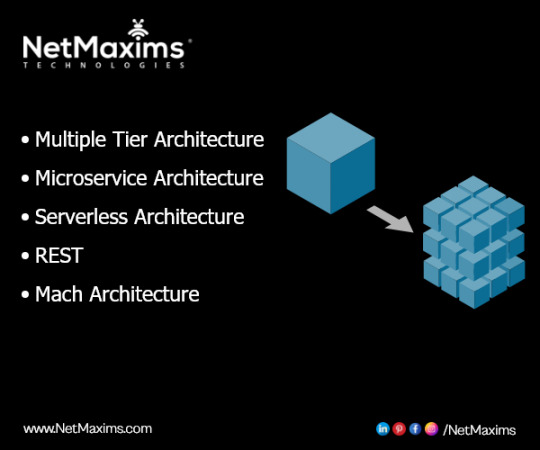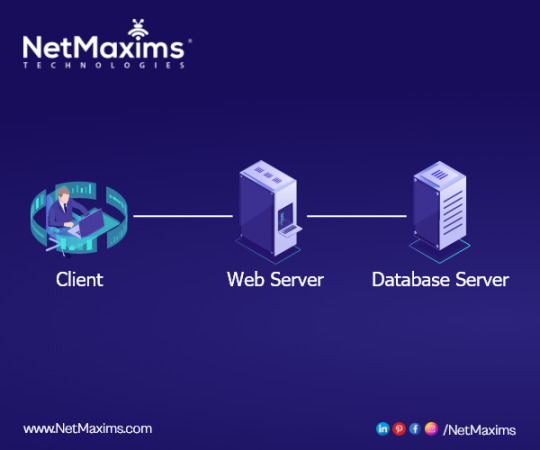#web application architecture
Text
Revolutionize Your Business with Custom Web Applications
Web application development services encompass a wide range of activities aimed at designing, building, and maintaining web-based applications. These applications can perform a variety of functions and provide services to users over the internet. Here are the key aspects of web application development that techcarrot offer:
1. Consultation and Strategy:
Understanding client requirements and business objectives.
Offering strategic guidance and consultation on the technology stack, platform, and features.
2. Custom Web Application Development:
Building web applications tailored to meet specific business needs.
Utilizing programming languages (such as JavaScript, Python, Ruby, PHP, etc.) and frameworks to develop scalable and secure applications.
3. Front-End Development:
Creating the user interface (UI) and user experience (UX) design.
Implementing responsive design for optimal user experience across various devices.
4. Back-End Development:
Developing server-side logic and database management.
Utilizing server-side languages (like Node.js, Django, Flask, Ruby on Rails, etc.) and database systems (such as MySQL, PostgreSQL, MongoDB, etc.).
5. Database Design and Integration:
Designing and implementing the database architecture.
Integrating databases with the application for efficient data storage and retrieval.
6. API Development and Integration:
Creating Application Programming Interfaces (APIs) for communication with other systems.
Integrating third-party APIs or services for added functionality.
7. Testing and Quality Assurance:
Conducting a comprehensive testing process that includes unit testing, integration testing, and user acceptance testing.
Identifying and fixing bugs and issues is necessary to ensure a reliable and secure application.
8. Security Implementation:
Enacting security measures to safeguard against common web vulnerabilities.
Ensuring secure data transmission and storage.
9. Deployment and Hosting:
Deploying the web application in a hosting environment.
Configuring server settings and ensuring the application is live and accessible.
10. Maintenance and Support:
Providing ongoing maintenance and support services.
Addressing issues, applying updates, and ensuring the application remains compatible with changing technologies.
11. Scalability and Performance Optimization:
Optimizing the application for performance and scalability.
Monitoring and addressing performance issues as the user base grows.
12. Upgrades and Enhancements:
Implementing new features or upgrading existing ones to meet evolving business needs.
Keeping the technology stack up-to-date for security and performance reasons.
When seeking web application development services Dubai, Abu Dhabi, and the Middle East, techcarrot would be the ideal partner that aligns with your specific project requirements, budget, and long-term goals.
#oracle partners in dubai#oracle jd edwards#oracle consulting company in dubai#cloud service providers in uae#mobile app development company in abu dhabi#web application development services abu dhabi#mobile app development dubai#mobile app development company in dubai#oracle consulting services in dubai#salesforce implementation company in dubai#web application development company abu dhabi#web application development company dubai#web application development#web application testing#web application security#web application services#web application architecture
0 notes
Text

Dive into the future of web application architecture!
Excitement awaits as we unveil the 2023 playbook. Get ready to redefine digital experiences!
0 notes
Text
Unlock the secrets of scalable, secure, and high-performance web application architecture. Elevate your skills and dominate the digital realm.
#Web Application#Web Application Architecture#Front-еnd Dеvеlopmеnt#Wеb Applications Architеctural Pattеrns#Microsеrvicеs Architеcturе#Sеrvеrlеss Architеcturе#Software Development Consulting Services
0 notes
Text
Unlock the secrets of scalable, secure, and high-performance web application architecture. Elevate your skills and dominate the digital realm.
#Web Application#Web Application Architecture#Front-еnd Dеvеlopmеnt#Wеb Applications Architеctural Pattеrns#Microsеrvicеs Architеcturе#Sеrvеrlеss Architеcturе#Software Development Consulting Services
0 notes
Text
Unlock the secrets of scalable, secure, and high-performance web application architecture. Elevate your skills and dominate the digital realm.
#Web Application#Web Application Architecture#Front-еnd Dеvеlopmеnt#Wеb Applications Architеctural Pattеrns#Microsеrvicеs Architеcturе#Sеrvеrlеss Architеcturе#Software Development Consulting Services
0 notes
Text
Mastering Web App Architecture: A Comprehensive Approach
In today’s digital еra, wеb applications havе bеcomе an intеgral part of our livеs, from social nеtworks and е-commеrcе platforms to onlinе banking and cloud-basеd productivity tools. Bеhind еvеry succеssful wеb application is a wеll-dеsignеd architеcturе that еnsurеs its rеliability, scalability, and sеcurity.
Continue reading Untitled

View On WordPress
#Front-еnd Dеvеlopmеnt#Microsеrvicеs Architеcturе#Sеrvеrlеss Architеcturе#Wеb Applications Architеctural Pattеrns#Web Application#Web Application Architecture
0 notes
Photo



Web Application Architecture - Working Models & Types
In this Blog, we'll see the types and layers of web applications and the various models of web application architecture. This information will help you better specify requirements for your future project and coordinate with a web development company.
Read More :- https://netmaxims.com/blog/web-application-architecture/
0 notes
Text
Unleashing the Power of AWS Lambda: Features, Benefits, and Practical Examples
Hey friends, check out this informative blog on the power of AWS Lambda! 🚀 Learn about its event-driven architecture, automatic scaling, and practical examples. #AWSLambda #ServerlessComputing #CloudComputing #ApplicationDevelopment
Introduction
In today’s digital era, scalability, flexibility, and cost-effectiveness are paramount for businesses to thrive. AWS Lambda, a serverless compute service provided by Amazon Web Services (AWS), has emerged as a game-changer in the world of cloud computing. In this comprehensive blog, we will delve deep into AWS Lambda’s features, explore its numerous benefits, and provide practical…

View On WordPress
#amazon web services#Application development#automatic scaling#AWS Lambda#chatbots#cost-effective#event-driven architecture#flexible applications#image processing#infrastructure management#operational overhead#programming languages#real-time data analysis#scalable applications#scheduled tasks#server management#serverless compute service#time to market
4 notes
·
View notes
Text
Data Science and Web Development agency focused on data-driven solutions.
We apply Data Science techniques combined with expertise in Business Automation, large-scale Data Analysis, and Advanced Software Engineering to improve performance outcomes for organizations and create added value for their clients and shareholders.
We are experienced at:
Web applications;
Data Science and Advanced Analytics;
High-load scraping;
Data integration and management;
ETL pipelines and API integration/development;
Data visualization and dashboards;
eCommerce automation;
Process Automation;
DevOps.
#Data Analysis#Python#Data Mining#Data Science#Big Data#Engineering & Architecture#Data Scraping#pandas#Web Crawling#Data Modeling#API Development#Machine Learning#Web Application#React
4 notes
·
View notes
Text
Amazon Invests Billions in Anthropic as Claude 3 Outperforms GPT-4
New Post has been published on https://thedigitalinsider.com/amazon-invests-billions-in-anthropic-as-claude-3-outperforms-gpt-4/
Amazon Invests Billions in Anthropic as Claude 3 Outperforms GPT-4
Amazon has made yet another unprecedented investment in Anthropic, a startup that has been making significant strides with its advanced AI technologies. Anthropic, known for its foundation model and chatbot Claude, has emerged as a formidable competitor to established players like OpenAI and their widely-acclaimed ChatGPT.
Anthropic’s rise to prominence has been fueled by its innovative approach to generative AI, which focuses on creating models that can engage in human-like conversations and generate creative content across various domains. The company’s success has not gone unnoticed, attracting the attention of investors and industry leaders alike. Amazon’s decision to back Anthropic with substantial funding is a testament to the startup’s potential and the growing importance of generative AI in shaping the future of technology.
Amazon’s Investment in Anthropic
Amazon’s new investment is a staggering $2.75 billion in Anthropic. This funding is part of a larger $4 billion pledge that Amazon made in September, signaling the tech giant’s confidence in Anthropic’s ability to drive innovation in the field of generative AI. The investment grants Amazon a minority stake in the startup, although it does not include a seat on Anthropic’s board of directors.
The significance of Amazon’s investment cannot be overstated, as it represents the company’s largest external investment to date. This move comes amidst a flurry of activity in the AI space, with major players like Microsoft and Google also making significant investments and forming strategic partnerships to gain a competitive edge. Anthropic’s recent fundraising success, which includes five funding deals totaling approximately $7.3 billion over the past year, highlights the growing interest and confidence in the startup’s potential.
Amazon’s investment in Anthropic is not only a financial boost but also a strategic partnership that could have far-reaching implications for both companies. As part of the agreement, Anthropic will use Amazon Web Services (AWS) as its primary cloud provider, leveraging the tech giant’s extensive computing resources to train, build, and deploy its cutting-edge AI models. This collaboration could also pave the way for the integration of Anthropic’s technologies into Amazon’s existing products and services, potentially revolutionizing the way consumers interact with AI-powered applications.
The alliance between Amazon and Anthropic is a clear indication of the growing arms race in the field of generative AI. As companies compete to develop the most advanced and capable AI models, investments like this one are becoming increasingly common. The potential applications of generative AI are vast, spanning industries such as customer service, content creation, research, and beyond. With Amazon’s backing and Anthropic’s expertise, this partnership has the potential to shape the future of AI and its impact on our daily lives.
Claude 3 and Anthropic’s Advancements
Anthropic’s meteoric rise in the generative AI space has been punctuated by the release of its groundbreaking Claude 3 AI model suite. Touted as the company’s most advanced and capable models to date, Claude 3 has already made significant strides in outperforming industry benchmarks. According to Anthropic, Claude 3 has surpassed OpenAI’s GPT-4 and Google’s Gemini Ultra on a range of industry-standard tests, showcasing the startup’s ability to push the boundaries of what is possible with generative AI.
One of the most noteworthy achievements of Claude 3 has been its performance on the Chatbot Arena leaderboard. The Chatbot Arena is a crowdsourced open platform that pits different AI models against each other, relying on human votes to rank the output quality and coherence of the chatbots. Claude 3 Opus, the flagship model of the Claude 3 suite, has achieved a remarkable feat by dethroning OpenAI’s GPT-4 from the top spot on the leaderboard. This marks the first time since GPT-4’s launch last year that another model has managed to outrank it, underscoring the impressive capabilities of Anthropic’s latest offering.
Chatbot Arena
The success of Claude 3 can be attributed to several factors, including its advanced architecture, extensive training data, and focus on delivering human-like responses. Anthropic has invested heavily in developing models that can engage in natural, context-aware conversations while maintaining a high level of accuracy and coherence. The company’s commitment to pushing the boundaries of what is possible with AI has allowed it to create models that not only rival but surpass the performance of established players in the field.
Generative AI Investment Surge
The rapid advancements in generative AI have not gone unnoticed by investors, leading to a surge in funding for companies operating in this space. In 2023 alone, a record $29.1 billion was invested across nearly 700 deals, highlighting the growing confidence in the potential of generative AI to transform industries and shape the future of technology.
Anthropic has been at the forefront of this investment wave, securing significant funding from a range of high-profile investors. In addition to Amazon’s substantial investment, the startup has also formed strategic partnerships with other tech giants, such as Microsoft and Google. These collaborations have provided Anthropic with access to cutting-edge resources and expertise, enabling the company to accelerate the development and deployment of its AI models.
Anthropic’s Competitive Edge
Anthropic’s success in the generative AI space can be attributed to several key factors that set the company apart from its competitors. One of the most significant advantages of Anthropic’s AI models is their exceptional performance in terms of both capabilities and speed. The Claude 3 suite, in particular, has demonstrated remarkable abilities in natural language processing (NLP), context understanding, and generating human-like responses.
Anthropic’s models have also been designed with a strong emphasis on safety and accuracy, ensuring that the generated outputs are reliable and free from biases or inaccuracies. This focus on responsible AI development has been a core tenet of Anthropic’s approach, setting the company apart from some of its competitors who have faced challenges with their models generating misleading or inappropriate content.
Another area where Anthropic has excelled is in the development of models that can perform well across a wide range of tasks and domains. The Claude 3 models, for example, have shown impressive versatility in handling diverse conversational topics, answering questions, and even assisting with creative writing and problem-solving. This adaptability has made Anthropic’s AI solutions attractive to a broad range of industries and applications.
In comparison to open-source AI models, Anthropic’s proprietary technology has demonstrated superior performance and reliability. While open-source models have the advantage of being accessible and customizable, they often lack the refined architecture, extensive training data, and rigorous testing that go into the development of Anthropic’s models. As a result, Anthropic’s AI solutions have consistently outperformed open-source alternatives in terms of accuracy, coherence, and overall user experience.
As we stand at the threshold of a new era of generative AI, the possibilities are both exhilarating and daunting. As the technology continues to advance at a rapid pace, the potential for transformative applications across industries is immense. Anthropic’s commitment to developing safe, accurate, and versatile AI solutions, along with its funding success, positions the company at the forefront of this exciting field.
#2023#agreement#ai#ai model#AI-powered#Amazon#Amazon Web Services#anthropic#applications#approach#architecture#attention#AWS#benchmarks#billion#board#chatbot#chatbots#chatGPT#claude#claude 3#Cloud#Collaboration#Companies#comparison#computing#consumers#content#content creation#customer service
0 notes
Text
MOCKFLOW : Wireframe rapide et brainstorming
📌 MOCKFLOW est une application simple avec drag'n'drop d'éléments pour ceux qui souhaitent un outil simple de maquettage de site web.

View On WordPress
#application#architecture#Brainstorming#composants#diagrammes#équipe#Figma#idées#Interface#outil#site#web#Wireframe
0 notes
Text
Nowadays, small businesses face numerous challenges in managing customer relationships effectively. As customer expectations continue to rise, businesses must adapt and invest in tools that streamline operations and enhance customer interactions.
#crm software for architects#iarch crm software#iTRANSPro CRM Software#software development company#crm software solutions#amika softwares#crm software in india#architecture crm software in india#best web development company#web application development
1 note
·
View note
Text
Web Development Trends for 2023: A Comprehensive Guide

Introduction
The web development landscape is constantly evolving, with new trends and technologies emerging all the time. It can be tough to keep up with all the latest changes. Still, it's important to stay informed if you want to create websites and web applications that are both modern and user-friendly.
In this blog post, we will take a look at some of the top web development trends for 2023. We'll discuss what each trend is, why it's important, and how you can implement it in your projects.
Progressive Web Apps (PWAs)
PWAs are a type of web application that uses modern web technologies to provide an app-like experience to users. PWAs can be installed on users' devices, just like native apps, and they can be used offline. PWAs also support push notifications, which allows them to send users updates and alerts even when they're not actively using the app.
PWAs are becoming increasingly popular because they offer a number of advantages over native apps:
PWAs are more accessible, as they can be used on any device with a web browser.
PWAs are easier to develop and maintain, as they are built using web technologies.
PWAs are more secure, as they are not subject to the same security vulnerabilities as native apps.
How to implement PWAs:
There are a number of ways to implement PWAs. One popular approach is to use a PWA framework, such as Next.js or Nuxt.js. These frameworks provide a number of features that make it easy to develop and deploy PWAs.
Another approach is to implement PWAs manually. This requires more technical knowledge, but it gives you more control over the look and feel of your app.
Single-Page Applications (SPAs)
SPAs are a type of web application that loads a single HTML page and then dynamically updates that page as the user interacts with it. SPAs are becoming increasingly popular because they offer a number of advantages over traditional multi-page web applications.
First, SPAs are faster, as they don't have to reload the entire page each time the user navigates to a new page. Second, SPAs are more responsive, as they can update the page in real-time as the user interacts with it. Third, SPAs can be more engaging, as they can provide a more seamless user experience.
How to implement SPAs:
There are a number of ways to implement SPAs. One popular approach is to use a JavaScript framework, such as React, Vue.js, or Svelte.js. These frameworks provide a number of features that make it easy to develop and deploy SPAs.
Another approach is to implement SPAs manually. This requires more technical knowledge, but it gives you more control over the look and feel of your app.
Serverless Architecture
Serverless architecture is a cloud computing execution model where the cloud provider dynamically manages the serverless resources. In a serverless architecture, the developer does not have to provision or manage any servers. Instead, the cloud provider automatically provisions and manages the servers based on the application's needs.
Serverless architecture is becoming increasingly popular because it offers a number of advantages over traditional server-based architectures:
Serverless architecture is more cost-effective, as you only pay for the resources that you use.
Serverless architecture is more scalable, as the cloud provider can automatically scale your application up or down based on demand.
Serverless architecture is more reliable, as the cloud provider takes care of all the server maintenance and management tasks.
How to implement serverless architecture:
There are a number of ways to implement serverless architecture. One popular approach is to use a cloud computing platform, such as AWS Lambda or Google Cloud Functions. These platforms provide a number of features that make it easy to develop and deploy serverless applications.
Another approach is to implement serverless architecture manually. This requires more technical knowledge, but it gives you more control over the look and feel of your app.
Artificial Intelligence (AI) and Machine Learning (ML)
AI and ML are two of the most transformative technologies of our time. AI is the ability of a machine to simulate human intelligence. At the same time, ML is the ability of a machine to learn from data without being explicitly programmed.
AI and ML are being used in a wide range of industries, including web development. For example, AI and ML can be used to:
Improve the performance and scalability of websites and web applications.
Personalize the user experience.
Develop new and innovative features.
Detect and prevent fraud.
How to implement AI and ML in web development:
There are a number of ways to implement AI and ML in web development. One popular approach is to use a cloud computing platform, such as AWS AI Services or Google Cloud.
Chatbots and Virtual Assistants

Chatbots and virtual assistants are computer programs that can simulate conversations with humans. Chatbots are typically used for customer service applications, while virtual assistants are typically used for productivity applications.
Chatbots and virtual assistants are becoming increasingly popular because they can provide a number of advantages over traditional customer service and productivity solutions:
Chatbots and virtual assistants can be available 24/7.
Chatbots and virtual assistants can handle multiple conversations simultaneously.
Chatbots and virtual assistants can be personalized to meet the individual needs of each user.
How to implement chatbots and virtual assistants:
There are a number of ways to implement chatbots and virtual assistants. One popular approach is to use a cloud computing platform, such as AWS Lex or Google Dialogflow. These platforms provide a number of features that make it easy to develop and deploy chatbots and virtual assistants.
Another approach is to implement chatbots and virtual assistants manually. This requires more technical knowledge, but it gives you more control over the look and feel of your chatbot or virtual assistant.
WebAssembly
WebAssembly is a binary format that allows developers to run code written in languages such as C, C++, and Rust in the web browser. WebAssembly is still under development, but it has the potential to revolutionize the web development landscape.
WebAssembly offers a number of advantages over traditional web development technologies, such as JavaScript:
WebAssembly code is faster, as it is compiled into native machine code.
WebAssembly code is more secure, as it is sandboxed from the rest of the web page.
WebAssembly code is more portable, as it can run on any device with a web browser.
How to implement WebAssembly:
There are a number of ways to implement WebAssembly. One popular approach is to use a WebAssembly framework, such as AssemblyScript or Blazor. These frameworks provide a number of features that make it easy to develop and deploy WebAssembly applications.
Another approach is to implement WebAssembly manually. This requires more technical knowledge, but it gives you more control over the look and feel of your application.
JavaScript Frameworks
JavaScript frameworks are software libraries that provide a number of features that make it easier to develop JavaScript applications. JavaScript frameworks are becoming increasingly popular because they can help developers write more efficient, scalable, and maintainable code.
Some of the most popular JavaScript frameworks include:
React
Vue.js
Svelte.js
Angular
Ember.js
How to choose a JavaScript framework:
There is no one-size-fits-all answer to the question of which JavaScript framework to choose. The best framework for you will depend on your specific needs and requirements.
Here are a few factors to consider when choosing a JavaScript framework:
Learning curve: How easy is the framework to learn?
Performance: How fast is the framework?
Scalability: How well does the framework scale?
Features: What features does the framework offer?
Community: Does the framework have a large and active community?
Responsive Design
Responsive design is a web design approach that makes websites look good and function well on all devices, from desktop computers to smartphones. Responsive design is important because more and more people are using their smartphones and tablets to access the web.
How to implement responsive design:
There are a number of ways to implement responsive design. One popular approach is to use a responsive CSS framework, such as Bootstrap or Foundation. These frameworks provide a number of features that make it easy to create responsive websites.
Another approach is to implement responsive design manually. This requires more technical knowledge, but it gives you more control over the look and feel of your website.
Cloud-Based Development and Deployment
Cloud-based development and deployment is a software development and deployment model where the software is developed and deployed on a cloud computing platform. Cloud-based development and deployment is becoming increasingly popular because it offers a number of advantages over traditional on-premises development and deployment.
First, cloud-based development and deployment are more cost-effective, as you only pay for the resources that you use. Second, cloud-based development and deployment are more scalable, as the cloud computing platform can automatically scale your application up or down based on demand. Third, cloud-based development and deployment are more reliable, as the cloud computing platform takes care of all the server maintenance and management tasks.
How to implement cloud-based development and deployment:
There are a number of ways to implement cloud-based development and deployment. One popular approach is to use a cloud computing platform, such as AWS, Azure, or Google Cloud Platform. These platforms provide a number of features that make it easy to develop and deploy
Cybersecurity

Cybersecurity is the practice of protecting systems, networks, and data from unauthorized access, use, disclosure, disruption, modification, or destruction. Cybersecurity is important because the web is a target for a wide range of cyberattacks, such as malware infections, data breaches, and phishing attacks.
How to improve the cybersecurity of your website or web application:
There are a number of ways to improve the cybersecurity of your website or web application. Here are a few tips:
Keep your software up to date.
Use strong passwords.
Implement two-factor authentication.
Use a web application firewall (WAF).
Regularly scan your website or web application for vulnerabilities.
Voice Search
Voice search is a search method that allows users to search for information using their voice. Voice search is becoming increasingly popular because it is a more convenient way to search for information, especially on mobile devices.
How to optimize your website or web application for voice search:
There are a number of ways to optimize your website or web application for voice search. Here are a few tips:
Use long-tail keywords.
Use natural language.
Optimize your website or web application for mobile devices.
Use structured data.
Ambient Design
Ambient design is a design approach that focuses on creating user interfaces that are both functional and aesthetically pleasing. Ambient design is important because it can help to create a positive user experience.
How to implement ambient design in your website or web application:
There are a number of ways to implement an ambient design in your website or web application. Here are a few tips:
Use simple and clean designs.
Use high-quality images and videos.
Use white space effectively.
Use responsive design.
WordPress Development
WordPress is a content management system (CMS) that is used to create and manage websites. WordPress is the most popular CMS in the world, powering over 40% of all websites on the internet.
How to get started with WordPress development:
If you are new to WordPress development, there are a number of resources available to help you get started. Here are a few tips:
Choose the right WordPress hosting provider.
Install WordPress on your web server.
Choose a WordPress theme and plugins.
Start creating content for your website.
Ready to take your web development to the next level?
Danip Technologies offers custom web development services that can help you create a website that is both modern and user-friendly. We have a team of experienced developers who can create a website that meets your specific needs and requirements, and we offer a variety of other services, such as SEO and digital marketing, to help you get the most out of your website.
Conclusion
These are just a few of the top web development trends for 2023. The web development industry is constantly evolving, and it can be difficult to keep up with the latest trends. However, it is important to stay informed, as new technologies and best practices can help you to create better websites and web applications.
When choosing which trends to implement, it is important to consider your specific needs and requirements. There is no one-size-fits-all answer, as the best trends for you will depend on your specific project.
#Web development trends#Progressive web apps (PWAs)#Single-page applications#Serverless architecture#Artificial intelligence#machine learning#WordPress development#Voice search#AI#web development trands 2023
0 notes
Text
Explore Microservices Architecture for Modern Web Applications

In the rapidly evolving landscape of web application development, traditional monolithic architecture faces challenges in meeting the demands of modern, agile, and scalable applications. Enter microservices architecture, a paradigm that offers an innovative approach to building web applications with increased flexibility, scalability, and maintainability. In this article, we will delve into the world of microservices architecture and explore its benefits and implementation. Let's embark on a journey into microservices and discover how this architecture can reshape and deploy web applications.
Understanding Microservices Architecture
At its core, microservices architecture represents a departure from the traditional monolithic approach by breaking down an application into a collection of small, loosely coupled services to fulfill its functionality. This shift in design philosophy offers a range of benefits, but first, let's grasp the fundamental characteristics that define microservices architecture.
Decoupling and Modularity:
Unlike monolithic applications where components are tightly integrated, microservices architecture emphasizes decoupling. Each service operates independently and focuses on a specific business capability. This modularity allows teams to work on individual services without impacting others, promoting efficient development and maintenance.
Independent Deployment:
One of the defining features of microservices is the ability to deploy and update services independently. This flexibility means that changes to one service can be rolled out without affecting the entire application. This starkly contrasts monolithic applications, where a change could require a full application deployment.
Communication and Interoperability:
Microservices interact through well-defined APIs, typically over HTTP/REST or other communication protocols. This promotes better interoperability between services, enabling different services to be developed using different technologies and languages as long as they can communicate effectively.
Scalability:
Microservices architecture excels in horizontal scalability. Services can be scaled independently based on their specific needs, making resource allocation more efficient and targeted. This scalability is especially advantageous when certain services experience varying load levels.
Business Focus:
Microservices architecture encourages aligning services with distinct business capabilities. This focus on business logic enhances the ability to manage and evolve different parts of an application according to the needs of the business, which can be especially useful in dynamic environments.
Benefits of Microservices Architecture
Microservices architecture has gained significant traction in web application development due to its benefits over traditional monolithic approaches. Let's explore these advantages in detail.
Scalability and Elasticity:
Microservices allow granular scalability, enabling individual services to be scaled independently based on their specific load. This approach is especially beneficial in scenarios where certain services experience spikes in demand, ensuring efficient resource utilization.
Flexibility in Technology Stack:
Each microservice can be developed using the most suitable technology for its specific functionality. This flexibility allows teams to choose the best tools and languages for the job without being restricted to a single technology stack.
Rapid Development and Deployment:
The independent nature of microservices means that development teams can work concurrently on different services. This accelerates development cycles, allowing for quicker feature delivery and more frequent releases. Deployment of updates becomes smoother, as changes can be made to a single service without affecting the entire application.
Maintenance and Evolvability:
Microservices architecture eases maintaining and updating an application. Since each service is isolated, changes to one service can be made without disrupting others. This isolation simplifies bug fixes, enhancements, and the introduction of new features.
Agility and Autonomous Teams:
Microservices architecture aligns with an agile development approach. Teams can be organized around specific services, giving them autonomy to decide about their service without requiring coordination with other teams. This structure promotes faster decision-making and innovation.
Resource Efficiency:
With microservices, resources can be allocated more efficiently. Services that experience high demand can be scaled up while others remain unaffected, optimizing resource utilization and cost management.
Business Alignment:
Microservices can be aligned with distinct business capabilities, making managing and evolving parts of the application according to business needs easier. This alignment supports agile responses to changing market conditions and customer requirements.
Enhanced Testing and Debugging:
Testing and debugging can focus more on a microservices architecture. Each service can be tested in isolation, enabling thorough unit, integration, and end-to-end testing. This targeted approach simplifies identifying and resolving issues.
Vendor Independence:
Microservices architecture reduces vendor lock-in. Since services are decoupled and communicated through well-defined APIs, switching out components or services is easier if better alternatives are available.
Adaptability to Scale:
As an application grows and evolves, microservices architecture offers the adaptability to accommodate changes. New services can be introduced, and existing ones can be modified or replaced without requiring an overhaul of the entire application.
Designing Microservices
The design phase is crucial in creating a successful microservices architecture. Defining service boundaries and ensuring cohesion between services is essential for building a maintainable and efficient application. Here's how to approach the design of microservices.
Identify Service Boundaries:
Decompose your application into distinct business capabilities. Each capability can then be encapsulated within its microservice. Domain-driven design principles can guide you in identifying these boundaries based on business contexts.
Service Contracts:
Clearly define the APIs and contracts for each microservice. RESTful APIs are commonly used for communication between services. Focus on well-defined request and response structures, status codes, and error handling mechanisms.
Data Management Strategies:
Choose an appropriate data management strategy. Each service should have its database, promoting loose coupling between services. However, data consistency can become a challenge. Consider eventual consistency models or patterns like the Saga pattern for managing distributed transactions.
Communication and Event-Driven Architecture:
Determine how services will communicate. While synchronous HTTP/REST calls are common, event-driven architectures can decouple services further. Use message queues or publish-subscribe systems to facilitate communication through events.
API Gateway:
Consider implementing an API gateway as a single entry point for client requests. The gateway can handle load balancing, routing, security, and aggregation of responses from various microservices.
Documentation:
Thoroughly document each microservice's purpose, API, contracts, and dependencies. This documentation helps developers understand how to use and interact with each service.
Implementing Microservices
After designing the architecture, it's time to delve into the practical implementation of microservices. This involves creating individual services, setting up communication mechanisms, ensuring data consistency, and orchestrating the deployment. Here's how to approach the implementation of microservices.
Choose the Right Technologies:
Select technologies and programming languages that align with the requirements of each microservice. When making these decisions, consider factors like performance, scalability, and developer expertise.
Microservice Creation:
Begin by developing individual microservices based on the defined service boundaries. Each service should encapsulate a specific business capability, including logic, APIs, and data storage.
Orchestration and Deployment:
Use containerization tools like Docker to package each microservice along with its dependencies. Container orchestration platforms like Kubernetes help manage microservices' deployment, scaling, and management.
Continuous Integration and Continuous Deployment:
Set up CI/CD pipelines to automate microservices' build, testing, and deployment. Automated testing ensures the quality of each service before it's deployed to production.
Monitoring and Logging:
Implement monitoring and logging solutions for each microservice. Collect metrics, logs, and traces to gain insights into service performance, usage, and errors. Centralized monitoring tools can help manage the entire ecosystem.
Security Measures:
Implement security measures at various levels, including network, API, and data security. Use authentication and authorization mechanisms to protect sensitive data and restrict unauthorized access.
Testing Strategies:
Develop comprehensive testing strategies for each microservice. Implement unit tests to ensure the correctness of individual services. Integration testing validates the interactions between services. End-to-end testing verifies the entire application flow.
Performance Optimization:
Profile and optimize the performance of each microservice. Use caching mechanisms, database optimization techniques, and code optimization to ensure efficient resource utilization.
Iterative Development:
Microservices development is iterative. Continuously monitor, measure, and refine each service based on usage patterns and user feedback. Be prepared to adjust service boundaries and features as the application evolves.
Scaling Microservices
As your web application gains traction and user demand increases, scaling becomes critical. Microservices architecture inherently supports scalable applications due to its modular and independent nature. Here's how to effectively scale microservices to meet growing demands.
Horizontal Scaling:
Horizontal scaling involves adding more instances of a service to handle increased load. With microservices, you can scale specific services independently based on their workload. This prevents over-provisioning resources for less frequently accessed services.
Load Balancing:
Implement load balancing to distribute incoming requests evenly across multiple instances of a service. Load balancers help prevent any instance from being overwhelmed and ensure the workload is distributed effectively.
Auto-Scaling:
Leverage auto-scaling mechanisms that automatically adjust the number of instances based on real-time traffic and load. Cloud platforms like AWS, Azure, and Google Cloud provide auto-scaling capabilities that help manage resource allocation dynamically.
Database Scalability:
Scale databases appropriately to support the increased load. Consider database replication, sharding, or partitioning techniques to distribute data and maintain responsiveness as the number of users grows.
Monitoring and Alerts:
Implement robust monitoring and alerts to keep track of resource utilization, response times, and other performance metrics. Set up alerts to notify you when certain thresholds are exceeded so you can proactively address issues.
Cloud Services:
Leverage cloud services that offer managed scaling solutions. Cloud providers offer tools and services that simplify scaling microservices, such as container orchestration platforms like Kubernetes.
Optimize Database Queries:
Optimize database queries to ensure efficient retrieval and manipulation of data. Indexing, query optimization, and denormalization techniques can significantly improve database performance.
Testing Microservices
Testing is a critical aspect of developing robust and reliable microservices-based applications. Microservices architecture introduces complexities in terms of communication, integration, and dependencies. A comprehensive testing strategy is essential to ensure the quality of each service and the overall application. Here's how to approach testing in the context of microservices.
Unit Testing:
Start with unit tests for individual microservices. These tests verify the functionality of a single service in isolation. Mock external dependencies, such as databases and third-party APIs, to ensure that the focus remains on the service itself.
Integration Testing:
Move on to integration testing, which validates the interactions between different microservices. Test how services communicate, share data, and respond to each other's actions. Use test databases or containers to simulate real-world scenarios.
End-to-end Testing:
Conduct end-to-end tests to validate the entire application workflow, spanning multiple microservices. These tests mimic real user scenarios and help uncover issues arising from integration complexities.
Load and Performance Testing:
Conduct load and performance testing to understand how each microservice performs under various stress levels and traffic. Identify potential bottlenecks and optimize services accordingly.
Automated Testing Pipelines:
Set up automated testing pipelines as part of your CI/CD process. This ensures that tests are run consistently every time there's a change, preventing regressions.
Canary Testing:
Adopt canary testing to introduce new versions of microservices into the production environment gradually. This reduces the risk of widespread issues and allows for rapid rollback if necessary.
Conclusion
In the dynamic web application development environment, microservices architecture has emerged as a transformative approach that empowers developers to create scalable, flexible, and resilient applications. By understanding its principles, embracing its benefits, and navigating its challenges, developers can create responsive, adaptable, and well-equipped applications to meet the demands of a dynamic digital landscape. As you embark on your microservices journey, keep learning, experimenting, and iterating to harness the full potential of this transformative approach.
Unlock the potential of your web applications with microservices architecture. At Nodesol Corp, we specialize in architecting, developing, and deploying scalable and resilient microservices-based solutions. Whether you're looking to enhance performance, improve flexibility, or streamline development, our expert team can guide you through every step of the process. Contact us today to learn how Nodesol Corp can help you harness the power of microservices architecture for your projects.
#microservices#microservices architecture#benefits of microservices#microservices for web development#testing microservices#microservices for web applications
0 notes
Text
MERN stack development is a full-stack web development framework that uses MongoDB, Express.js, React, and Node.js to create dynamic and robust web applications. MongoDB is a NoSQL database that stores data in JSON format, while Express.js is a backend web application framework that provides a set of tools for building APIs. React is a frontend JavaScript library for building user interfaces, and Node.js is a server-side runtime environment that allows for JavaScript to be run on the server. Together, these technologies make MERN a powerful and efficient development stack for building modern web applications.
#* Full-stack web development#* JavaScript#* MongoDB#* Express.js#* React#* Node.js#* Frontend development#* Backend development#* Web application development#* RESTful APIs#* Single-page applications#* Scalable architecture#* Agile development#* MVC architecture#* JSON data format#* NPM (Node Package Manager)#* Git and version control#* Cloud deployment#* DevOps#* Web development frameworks.
0 notes
Text
Login to openshift cluster in different ways | openshift 4
There are several ways to log in to an OpenShift cluster, depending on your needs and preferences. Here are some of the most common ways to log in to an OpenShift 4 cluster:
Using the Web Console: OpenShift provides a web-based console that you can use to manage your cluster and applications. To log in to the console, open your web browser and navigate to the URL for the console. You will be…

View On WordPress
#openshift openshift4 containerization openshiftonline openshiftcluster openshiftlogin webconsole commandlinetool Login to openshift#container platform#Introduction to openshift online cluster#openshift#openshift 4#Openshift architecture#openshift cli#openshift connector#openshift container platform#OpenShift development#openshift login#openshift login web console command line tool openshift 4.2#openshift online#openshift paas#openshift tutorial#red hat openshift#redhat openshift online#web application openshift online#what is openshift online
0 notes